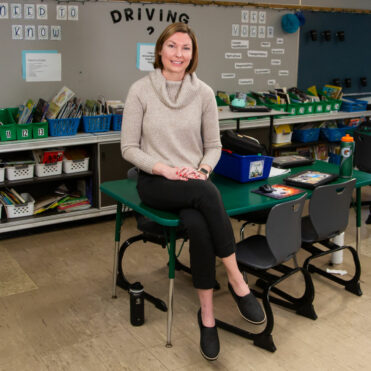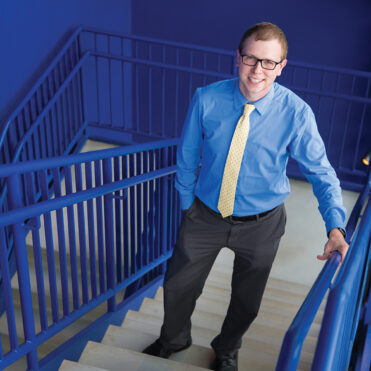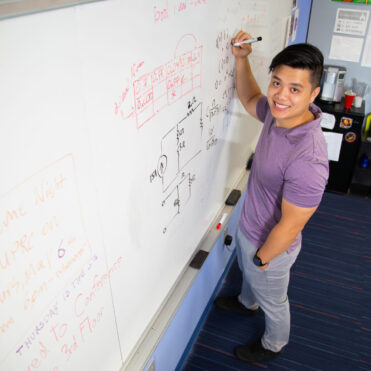David Copsey
David Copsey was midway through the BGSU respiratory care program when the COVID-19 pandemic hit. But it only strengthened his passion for helping patients.
David Copsey does not know what it feels like to be a registered respiratory therapist in a pre-pandemic world.
Instead, he knows the stress he feels when every bed in the intensive care unit is filled. He knows the feeling of loss that comes when he goes into the hallway to grab a ventilator and wheels the last one back to his patient. And he knows what defeat feels like, holding his patient’s hand as they take their last breath with their family members comforting them through the screen of an iPad.
But still, Copsey wouldn’t trade a minute of it.
“It’s hard sometimes. There are a lot of times I’m crying; there are a lot of times I’m frustrated,” Copsey says. “But I still wouldn’t change it for the world because I’m constantly helping people every single day, which I love to do.”
A crashing moment
Copsey, the first in his family to pursue a medical career, says that love of helping others led him to Lorain County Community College’s nursing program at first. He was a clinical technician with the Cleveland Clinic at the time and assumed nursing was the logical next step, but after shadowing a respiratory therapist for a day, Copsey changed course.
“There was a situation with one of our patients where they were crashing,” Copsey recalls. “Their oxygen was super low and their heart rate was dropping and the doctors were getting ready to code the patient.”
Copsey says the second that code became official, the registered respiratory therapist took complete control of the room.
“What I saw was the respiratory therapist at the head of the bed with the physician, working on putting the tube in and securing the airway,” he says. “And at that time, that was the most important thing of the entire operation — making sure that we could get them to breathe.”
Copsey knew in that moment that he wanted to learn how to administer the life-saving critical technique that respiratory therapists use every day.
“I’m paying community college prices for a four-year university education.”
David Copsey - LCCC University Partnership graduate & student
Thrown into the fire
Once Copsey confirmed his calling, he chose LCCC’s University Partnership program because it paired Bowling Green State University’s reputable respiratory care program with LCCC’s low tuition rates.
“I knew it was a great respiratory care program,” Copsey says. “The thought of having that bridge between a community college and a four-year university was a big draw for me. And I’m paying community college prices for a university education.”
Copsey was in his second year in the associate of applied science in respiratory care program, which is now a pathway to the bachelor’s of science degree in respiratory care, when the COVID-19 pandemic crashed into his world. Because Ohio allows respiratory therapist students to work under the guidance of a registered respiratory therapist, Copsey and his entire class began assisting patients immediately.
“By mid-2020 we got to work with these COVID-19 patients,” Copsey says. “And then as soon as we graduated, they threw us right into the fire of the pandemic. And it’s been very stressful.”
But, thanks to his training, Copsey was ready. He says the combination of classwork, lab time, and clinical experience was rigorous and the perfect preparation.
During classroom hours, he and his classmates studied the physics behind ventilators. They became familiar with the various viruses and diseases that impact respiratory function. In the labs, Copsey spent hours working with the mannequins, manipulating the lungs to mimic the actions he’d encounter in the medical field.
All this time in the classroom and lab prepared Copsey for the clinical portion of the program. He racked up close to 1,000 hours of real-world training, floating between specialty areas such as pediatrics, the intensive care unit, home care, and sleep labs.
“During clinicals, they let us do everything that we had learned here in the classroom. There were no limitations,” he says.
A calling to help and inspire
Copsey graduated in December 2020 with his associate of applied science in respiratory care and is now working toward his bachelor's of applied health science degree with a respiratory care specialization. Beyond training, Copsey says his passion for helping others plays a big role in his ability to do his job, especially during a pandemic. And while his emotions drive to desire to provide patient care, he must rely on his training alone to administer it.
“We see people at their worst, we see people at their sickest,” he says. “But you have to put your feelings aside when everything is happening. You have to keep calm in stressful situations.”
The influx of stressful situations won’t be waning any time soon. Just last week the Cleveland Clinic invited Ideastream Public Media health reporters into the ICU to talk about the worsening pandemic. In the article, Copsey’s colleagues in respiratory care said this is the worst they have seen during the pandemic, “not just in numbers but also in terms of how sick patients are.”
Just when healthcare workers are most needed, the entire country is experiencing a shortage, partly due to burnout. The Cleveland Clinic alone has dozens of respiratory therapy job openings, most including sign-on bonuses. But Copsey understands that while the pandemic has strengthened his commitment to healthcare, it has pushed others out of the field.
“Other people’s instincts were to leave when the pandemic hit, but for me this job is truly a calling,” he says. “While it’s difficult every day to watch and work through taxing shifts, knowing that I was able to be there for my patients and coworkers is very rewarding.”
Although the pandemic has often left Copsey emotionally, mentally, and physically drained at the end of those shifts, he can see slivers of light in each day.
“The caregivers that have been taking care of these patients have become experts in predicting the course of action needed to implement the proper care plan,” Copsey says. “That’s what gives me hope for the future of this pandemic, that we have brilliant people working hard every day to end the COVID-19 crisis.”



